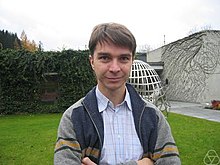Stanislav Smirnov
Stanislav Smirnov | |
|---|---|
 | |
| Born | 3 September 1970 |
| Nationality | Russian |
| Alma mater | Saint Petersburg State University California Institute of Technology |
| Awards | Clay Research Award (2001) Salem Prize (2001) Rollo Davidson Prize (2002) EMS Prize (2004) Fields Medal (2010) |
| Scientific career | |
| Fields | Mathematics |
| Institutions | University of Geneva Royal Institute of Technology Saint Petersburg State University Yale University Max Planck Institute for Mathematics IAS Princeton |
| Thesis | Spectral Analysis of Julia Sets (1996) |
| Doctoral advisor | Nikolai G. Makarov |
Stanislav Konstantinovich Smirnov (Russian: Станисла́в Константи́нович Cмирно́в; born 3 September 1970) is a Russian mathematician currently working at the University of Geneva, who was awarded the Fields Medal in 2010. His research focuses on the fields of complex analysis, dynamical systems and probability theory.[1][2]
Career
Smirnov attended a specialist mathematics school, Saint Petersburg Lyceum 239, until 1987. Smirnov completed his undergraduate degree at Saint Petersburg State University in 1992, where he worked under Victor Havin.[3] His PhD was conducted at Caltech under advisor Nikolai G. Makarov; his thesis was entitled Spectral Analysis of Julia Sets and he received his doctorate in 1996.[4] Smirnov has held research positions at Yale University, the Max Planck Institute for Mathematics in Bonn, and the Institute for Advanced Study in Princeton.[3][5] In 1998 he moved to the Royal Institute of Technology in Stockholm, and took up his current position as a professor in the Analysis, Mathematical Physics and Probability group at the University of Geneva in 2003.[3][6]
Research
Smirnov is known best for his work on critical percolation theory, in which he proved Cardy's formula for critical site percolation on the triangular lattice, and deduced conformal invariance.[5] The conjecture was proved in the special case of site percolation on the triangular lattice.[7] Smirnov's theorem has led to a fairly complete theory for percolation on the triangular lattice, and to its relationship to the Schramm–Loewner evolution introduced by Oded Schramm. He has obtained corresponding results of conformality for the random-cluster model and Ising model in two dimensions.[8]
Awards
Smirnov was jointly ranked first in the 1986 and 1987 International Mathematical Olympiads, with perfect scores and gold medals on both occasions.[9] He has been awarded the Saint Petersburg Mathematical Society Prize (1997), the Clay Research Award (2001), the Salem Prize (joint with Oded Schramm, 2001), the Göran Gustafsson Research Prize (2001), the Rollo Davidson Prize (2002), and the Prize of the European Mathematical Society (2004).[3]
In 2010 Smirnov was awarded the Fields medal for his work on the mathematical foundations of statistical physics, particularly finite lattice models.[10] His citation read "for the proof of conformal invariance of percolation and the planar Ising model in statistical physics".[11] In his laudation, Harry Kesten said that Smirnov "has the talent and insight to produce surprising results, and his work has been a major stimulus for the explosion in the last 15 years or so of probabilistic results about random planar curves".[12] After receiving the award, Smirnov expressed his wish to continue making important mathematical discoveries, saying "I look forward to proving more theorems. I hope the weight of this prize doesn't slow me down."[13]
In 2012 he became a fellow of the American Mathematical Society.[14]
Publications
- Probability and Statistical Physics in St. Petersburg, American Math Society, (2015)
References
- ^ "Stanislav Smirnov's publications on Google Scholar".
- ^ "Stanislav Smirnov's home page".
- ^ a b c d "La Médaille Fields pour un professeur de l'UNIGE". University of Geneva press releases (in French). University of Geneva. 19 August 2010. Retrieved 19 August 2010.
- ^ Stanislav Smirnov at the Mathematics Genealogy Project
- ^ a b "Clay Mathematics Institute".
- ^ "Stanislav Smirnov's page at the University of Geneva" (in French). University of Geneva. Retrieved 19 August 2010.
- ^ Smirnov, Stanislav (2001). "Critical percolation in the plane: conformal invariance, Cardy's formula, scaling limits". Comptes Rendus de l'Academie des Sciences. 333 (3): 239–244. Bibcode:2001CRASM.333..239S. doi:10.1016/S0764-4442(01)01991-7.
- ^ "Papers of Stanislav Smirnov".
- ^ "Stanislav Smirnov". International Mathematical Olympiad. Retrieved 19 August 2010.
- ^ Cipra, Barry A. (19 August 2010). "Fields Medals, Other Top Math Prizes, Awarded". Science Now. AAAS. Retrieved 19 August 2010.
- ^ Rehmeyer, Julie (19 August 2010). "Stanislav Smirnov profile" (PDF). International Congress of Mathematicians. Retrieved 19 August 2010.
- ^ Kesten, Harry (19 August 2010). "The Work of Stanislav Smirnov" (PDF). International Congress of Mathematicians. Retrieved 19 August 2010.
- ^ Bellos, Alex (19 August 2010). "Mathematics 'Nobel' rewards boundary-busting work". New Scientist. Reed Business Information Ltd. Retrieved 19 August 2010.
- ^ List of Fellows of the American Mathematical Society, retrieved 2013-07-20.
External links
![]() Media related to Stanislav Smirnov at Wikimedia Commons
Media related to Stanislav Smirnov at Wikimedia Commons
- Use dmy dates from September 2010
- 1970 births
- 20th-century mathematicians
- 21st-century mathematicians
- Fields Medalists
- Living people
- Russian mathematicians
- University of Geneva faculty
- Clay Research Award recipients
- Probability theorists
- Fellows of the American Mathematical Society
- International Mathematical Olympiad participants
